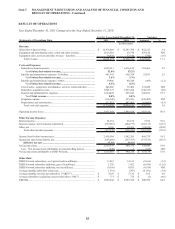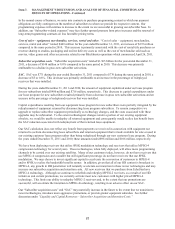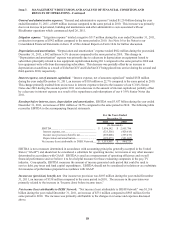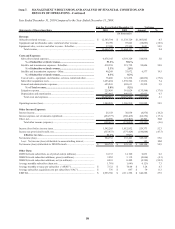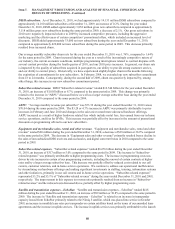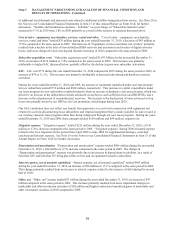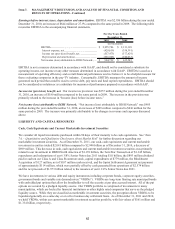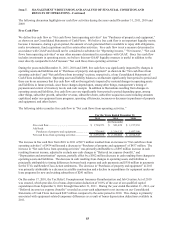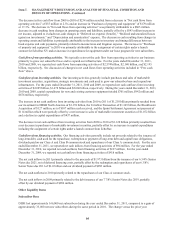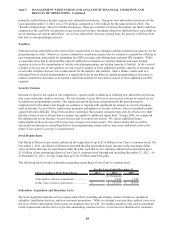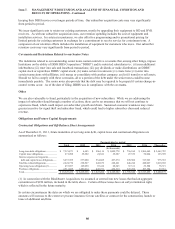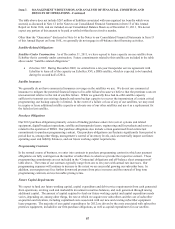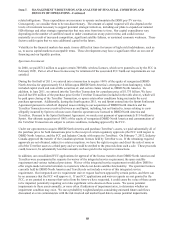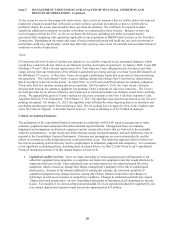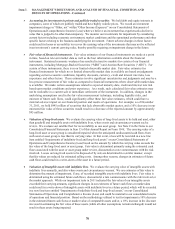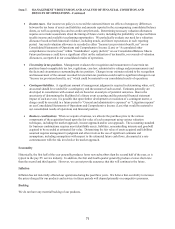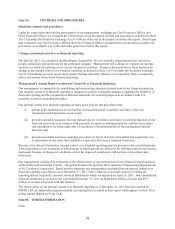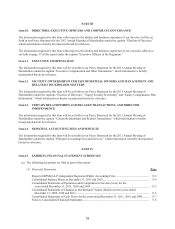Dish Network 2011 Annual Report Download - page 75
Download and view the complete annual report
Please find page 75 of the 2011 Dish Network annual report below. You can navigate through the pages in the report by either clicking on the pages listed below, or by using the keyword search tool below to find specific information within the annual report.
Item 7. MANAGEMENT’S DISCUSSION AND ANALYSIS OF FINANCIAL CONDITION AND
RESULTS OF OPERATIONS - Continued
65
65
primarily resulted from a decline in gross new subscriber activations. Our gross new subscriber activations for the
year ended December 31, 2011 was 2.576 million, compared to 3.052 million for the same period in 2010. See
“Results of Operations” above for further discussion. There are a number of factors that impact our future cash flow
compared to the cash flow we generate at any given point in time, including subscriber churn and how successful we
are at retaining our current subscribers. As we lose subscribers from our existing base, the positive cash flow from
that base is correspondingly reduced.
Satellites
Operation of our subscription television service requires that we have adequate satellite transmission capacity for the
programming we offer. Moreover, current competitive conditions require that we continue to expand our offering of
new programming, particularly by expanding local HD coverage and offering more national HD channels. While
we generally have had in-orbit satellite capacity sufficient to transmit our existing channels and some backup
capacity to recover the transmission of certain critical programming, our backup capacity is limited. In the event of
a failure or loss of any of our satellites, we may need to acquire or lease additional satellite capacity or relocate one
of our other satellites and use it as a replacement for the failed or lost satellite. Such a failure could result in a
prolonged loss of critical programming or a significant delay in our plans to expand programming as necessary to
remain competitive and cause us to expend a significant portion of our cash to acquire or lease additional satellite
capacity.
Security Systems
Increases in theft of our signal or our competitors’ signals could, in addition to reducing new subscriber activations,
also cause subscriber churn to increase. We use Security Access Devices in our receiver systems to control access
to authorized programming content. Our signal encryption has been compromised in the past and may be
compromised in the future even though we continue to respond with significant investment in security measures,
such as Security Access Device replacement programs and updates in security software, that are intended to make
signal theft more difficult. It has been our prior experience that security measures may only be effective for short
periods of time or not at all and that we remain susceptible to additional signal theft. During 2009, we completed
the replacement of our Security Access Devices and re-secured our system. We expect additional future
replacements of these devices will be necessary to keep our system secure. We cannot ensure that we will be
successful in reducing or controlling theft of our programming content and we may incur additional costs in the
future if our system’s security is compromised.
Stock Repurchases
Our Board of Directors previously authorized the repurchase of up to $1.0 billion of our Class A common stock. On
November 1, 2011, our Board of Directors extended the plan and authorized an increase in the maximum dollar
value of shares that may be repurchased under the plan, such that we are currently authorized to repurchase up to
$1.0 billion of our outstanding shares of our Class A common stock through and including December 31, 2012. As
of December 31, 2011, we may repurchase up to $1.0 billion under this plan.
The following table provides information regarding repurchases of our Class A common stock.
Class A Common Stock Re
p
urchases 2011 2010 2009
Total number of shares repurchased..................... - 6,020 1,948
Dollar value of shares repurchased...................... $ - $ 107,079 $ 18,594
(In thousands)
For the Years Ended December 31,
Subscriber Acquisition and Retention Costs
We incur significant upfront costs to acquire subscribers, including advertising, retailer incentives, equipment
subsidies, installation services, and new customer promotions. While we attempt to recoup these upfront costs over
the lives of their subscription, there can be no assurance that we will. We employ business rules such as minimum
credit requirements and we strive to provide outstanding customer service, to increase the likelihood of customers


